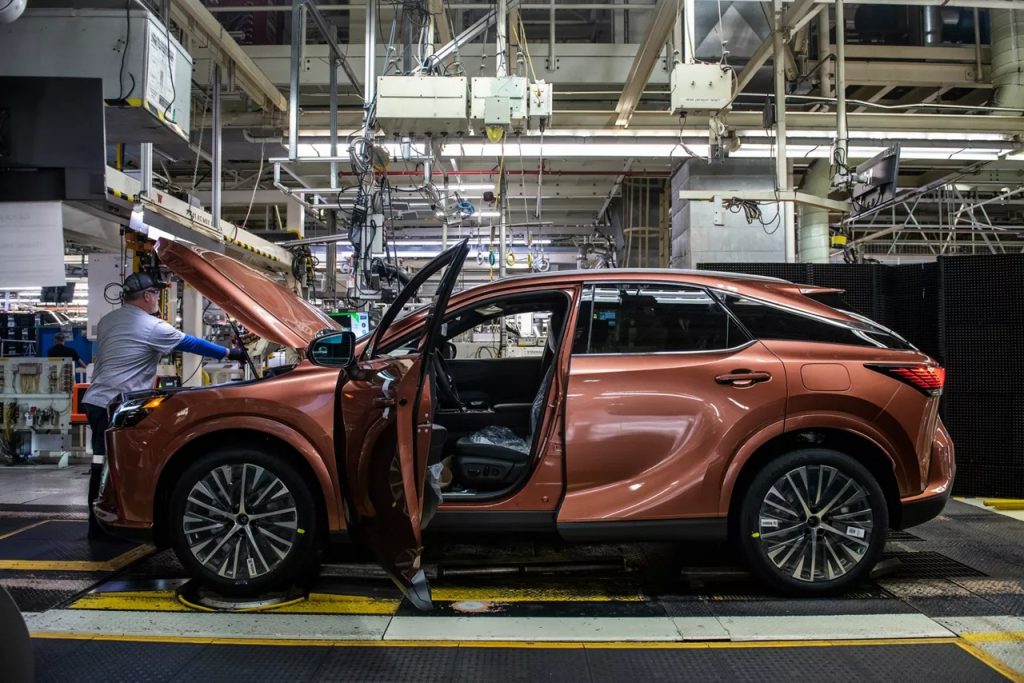Even before this week’s U.S. announcement that it will impose a hefty 25% tariff on all motor vehicle imports, the APA had begun fielding inquiries from consumers wanting to know which vehicles are made in Canada before they start shopping. That hasn’t been the case since the 1980s, when some buyers were concerned about the loss of North American jobs because of the onslaught of imported Japanese cars. At that time, cars like the Honda Civic and Toyota Corolla were rightly perceived as being of higher quality than small cars from the Big Three domestic carmakers, but the large increase in imports was hurting employment at North American assembly plants.


Since 1965 — long before the Free Trade agreement or the subsequent inclusion of Mexico under NAFTA in 1994, the manufacturing of auto parts and complete vehicles has been duty-free between Canada and the United States. This permitted a rationalization of automobile production: larger plants in Canada produced vehicles for both countries more economically. In return, Canada imported Made in USA (and later, Mexico) vehicles duty-free, at cheaper prices than they would have cost to manufacture in a small market like Canada.
The Auto Pact from 1965, and later free trade agreements turned out to be a lifesaver for the automotive industry in Canada. Consider that Australia, with a market similar in size and vehicle mix to Canada’s, once had a thriving home-grown auto industry. In 2017, Holden, a division of General Motors, closed Australia’s last automobile assembly plant because it was uneconomical to produce vehicles locally for a market the size of Australia’s.
The strategy behind proposing tariffs is to bring vehicle assembly back to the United States. That may benefit the U.S., but essentially breaks the USMCA agreement that President Trump himself negotiated and signed in the first term of his presidency. The tariffs, even if temporary, will have negative implications for vehicle assembly in Canada over the long term, as the automakers are likely to favour the U.S. in their planning to ensure tariff-free access to the large American market.
Should I buy a vehicle now?
The situation is very much in flux. If Canada imposes countervailing tariffs against U.S. assembled cars, you’ll be better off securing a U.S. assembled vehicle that has already landed in Canada from a dealer’s inventory. Fortunately, many vehicles coming into Canada are sourced outside of North America and their prices here will not be affected by the collapse of free trade with the U.S., as their nations of assembly are not in a trade war with Canada.
Made in Canada
Here is the complete list of 2025 models assembled in Canada:
General Motors
Silverado 1500 Pickup (excluding the EV model which is made in the US)
Ford
Ford does not currently assemble any complete vehicles in Canada.
Honda
Civic compact car
CR-V compact SUV, both gas any hybrid
Lexus
NX compact SUV, gas and hybrid
RX midsize SUV, gas and hybrid
(note: both vehicle Plug-In 450h+ models are built in Japan)
Stellantis (Chrysler, Dodge, Jeep, RAM, Fiat)
Chrysler Pacifica minivan
Chrysler Grand Caravan minivan
Dodge Charger
Toyota
RAV4, gas and hybrid (the Plug-In is built in Japan)
Where it’s assembled—other models
The APA prepared this chart showing the country of assembly for models commonly shopped by APA members using our new car buying service. You may be surprised to learn that the Audi Q5 and BMW 2 and 3-series models are now assembled in Mexico; the APA expects them to remain tariff-exempt when imported to Canada by rail through the United States, or subject to the current low tariff for imports which do not have sufficient North American content. With a high availability of production in Korea, Hyundai and Kia may actually experience a bounce relative to the competition in Canada if there are retaliatory tariffs on imports from the United States. Mazda will be clobbered in the U.S., as most of its vehicles are still assembled in Japan – perhaps the automaker will increase its Canadian allocations and incentives to absorb some of the pain. Canada is traditionally a receptive market for the Mazda brand, especially Quebec.
| Make | Model | Canada | USA | Mexico | Other |
| Acura | ADX | MEX | |||
| MDX | USA | ||||
| RDX | USA | ||||
| TL | USA | ||||
| Audi | Q5 | MEX | |||
| A3 | Hungary | ||||
| BMW | X1 | Germany | |||
| X2 | Germany | ||||
| X3 | USA | ||||
| X4 | USA | ||||
| X5 | USA | ||||
| X6 | USA | ||||
| X7 | USA | ||||
| 3-Series | MEX | ||||
| 2-Series Coupe | MEX | ||||
| 2-Series Hatch | Germany | ||||
| I4 | Germany | ||||
| M3 | Germany | ||||
| M4 | Germany | ||||
| M5 | Germany | ||||
| MINI | Countryman | Germany | |||
| Cooper | England | ||||
| Chevrolet | Trax | Korea | |||
| Trailblaxer | Korea | ||||
| Equinox | MEX | ||||
| Traverse | USA | ||||
| Silverado | CAN | USA | MEX | ||
| Ford | Escape | USA | |||
| Maverick | MEX | ||||
| Ranger | USA | ||||
| F-150 | USA | ||||
| Explorer | USA | ||||
| Bronco Sport | MEX | ||||
| Honda | Accord | USA | |||
| CR-V | CAN | ||||
| Civic | CAN | ||||
| Pilot | USA | ||||
| Ridgeline | USA | ||||
| HR-V | MEX | ||||
| Hyundai | Santa Fe (gas) | USA | |||
| Tucson (gas) | USA | ||||
| Sante Fe (hybrid) | Korea | ||||
| Tucson (hybrid/PHEV) | Korea | ||||
| Santa Cruz | USA | ||||
| Palisade | Korea | ||||
| Elantra | Korea | ||||
| Jeep | Compass | MEX | |||
| Grand Cherokee | USA | ||||
| Wrangler | USA | ||||
| Gladiator | USA | ||||
| Lexus | NX | CAN | |||
| NX PHEV | Japan | ||||
| RX | CAN | ||||
| RX PHEV | Japan | ||||
| ES | USA | ||||
| IS | Japan | ||||
| Mazda | 3 | Japan | |||
| MX-5 Miata | Japan | ||||
| CX-70 | Japan | ||||
| CX-90 | Japan | ||||
| CX-50 | USA | ||||
| Chrysler | Pacifica | CAN | |||
| Grand Caravan | CAN | ||||
| Toyota | Corolla 2L | USA | |||
| Corolla Cross | USA | ||||
| Camry | USA | ||||
| RAV4 | CAN | ||||
| Corolla Hatch | Japan | ||||
| GR Corolla | Japan | ||||
| Crown Signia | Japan | ||||
| bZ4X | Japan | ||||
| Land Cruiser | Japan | ||||
| 4Runner | Japan | ||||
| Highlander | USA | ||||
| Grand Highlander | USA | ||||
| Volkswagen | Atlas | USA | |||
| Jetta | MEX | ||||
| Tiguan | MEX | ||||
| Taos | MEX | ||||
| ID.4 | USA | ||||
